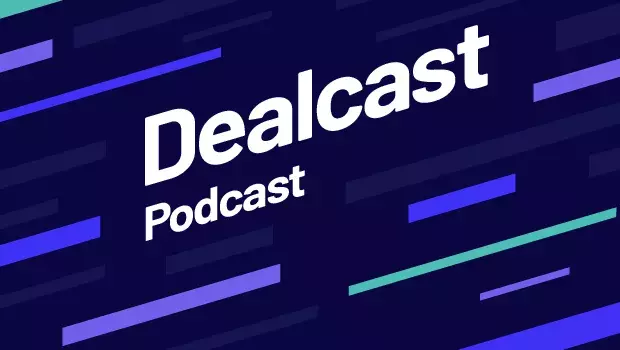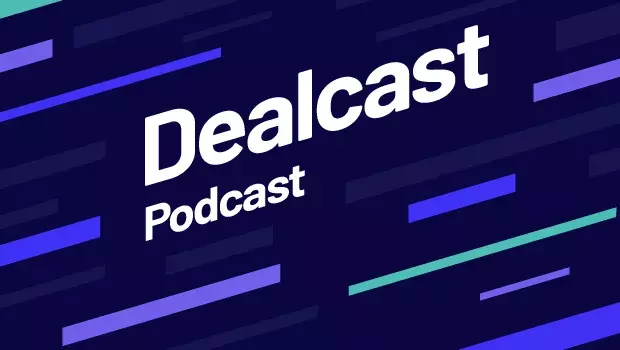M&A Tales: Alberto Onetti, Chairman of Mind the Bridge
On the second installment of the M&A Tales series, our special guest is Alberto Onetti, chairman of Mind the Bridge, a global open-innovation platform providing advisory services and products to corporates and local start-up ecosystems.
Onetti candidly discusses the challenges and opportunities of connecting established corporates with up-and-coming start-ups.
Dealcast is presented by Mergermarket and SS&C Intralinks.
Transcript
[MUSIC PLAYING]
Hello, and welcome to Dealcast.
It's the weekly M&A podcast, which is presented to you by Mergermarket and SS&C Intralinks. This is the second in a series of special episodes called M&A Tales, where you'll hear about the human side of M&A. These episodes are presented by Rupert Cocke, who's a Senior Editor and Head of Iberian Coverage for MergerMarket.
In this episode, Rupert discusses the lessons and difficulties of connecting corporates to startups. The special guest speaker is Alberto Onetti, Chairman of Mind the Bridge, which is a global open innovation platform providing services and products to corporates and to local startup ecosystems.
Thank you, Julie-Anna. I'm joined here today by Alberto Onetti, the chairman of Mind the Bridge, an innovation advisory firm.
Alberto, you've told me in the past that the corporate world and the startup world are very different. And you see them as having different languages almost. Would you like to explain to the listeners a little bit about how you see the difference between these two worlds?
Yeah, I think this is definitely a good point. And again, there are corporates. Startups are corporates, as well as established corporates. The problem is that established corporate has a long history, and most of the time, the fact that having a lot of history give them the presumption that have also a long future ahead of them.
While startups, they have no history, have very, very limited histories and everything is still ahead of them.
So everything is still under construction. Or again, there is something has been constructed and built on but still a lot to be built. And so, that probably explain the main difference between these two words.
There's a difference of perspective. Then there are also a lot of technical things that may make them work differently. The fact that most of the startups are venture-backed, meaning that investors that typically put money that is supposed to be returned in a time frame, that is ranging from five to eight years, probably give them a sense of pressure. They felt they probably are addressing new markets that are evolving continuously. Probably give them an extra pressure to move fast.
While established corporates, on the other hand, probably do not have these external pressures, also have-- so the way they are evaluated by the market is mostly focused on today on the quarterly results, the monthly results, rather than on what they are planning up for the future. So that's probably, again, my take on why these two worlds are so different.
And I guess, there's also an issue of failure that anyone who joins a startup knows that there's a fairly good risk that the project might not gain traction, it might fail, it might run into financing difficulties. And companies do, of course, go bankrupt in the corporate world, the mainstream corporate world as well. But it's probably less of a everyday threat. So do you feel like the different approaches to the possible failure of the project color the cultures?
Totally. Yes, I think that if you're doing something that is really innovating, really new, the most typical outcome is failing, is not being successful. And so, this is probably the mindset of startups. So they are doing something that is challenging by definition. And most of the time, they know that this might not work.
In the large corporate settings, failure is perceived as something that cannot even be mentioned. Again, failing is not an option for large corporation. That's the term means, an attitude of doing things that work, that have to work. And any possible not perfectly functioning is not even contemplated.
So this is the typical mainframe, mainstream culture of large corporation. That's also structural, a lot of additional things like compliance, legal. Again, there is a lot of functions that are designed to make everything works perfectly and on time without any possible disruption.
And so that's frame more probably also determine a culture where some bias is probably one of the typical traits.
OK, that's very interesting, Albert. I know that you have described yourself as being bilingual, that you can speak to both corporates and you can speak to the corporates. Would you explain to the listeners how that works in practice?
And I might jump in and give an example here from my own perspective as a financial journalist. I've sometimes had the experience of having a meeting with a startup, followed by a meeting with a corporate lawyer. And it's very difficult to know how to dress.
I'll go and see the founder of the startups who's wearing jeans and a T-shirt. And then I go and see the corporate lawyer who's wearing a full suit with a tie. And it's very difficult to dress in a way that makes both people feel comfortable. How do you feel that being bilingual across both worlds works in practice?
Again, being bilingual is the fact that I have done startups. I started companies. I failed. I got an exit. I got funded.
And I-- and I wear the shoes of a startups in multiple circumstances. Give you the sense of our difficulties moving such an environment.
On the other hand, as Mind the Bridge, we're working with large Fortune 500 companies. Again, or you are totally disconnected from your customers. And it is not an option, or you start learning how they think, how they work.
And so, I also used to understand all the political constraints, all the organizational constraints that large corporations have to live with. And at the end, I would love to wear my startup hat on my head 100% of the time. But at the end, if you want that something happens in the corporate environment, you need also to understand how to make it work and to make it digestible for the corporate settings.
And that is why you need to be fluent in a corporate in order to make some open innovation that it means startup corporate collaboration actually works. If not, you are just evangelizing people, and nobody will listen. Nobody will move a needle. And that is not exactly my goal.
OK, thank you. I think from someone who's coming at it from a corporate perspective, what are the advantages of working with startups?
But again, the reality is that no corporate today, whatever the size, the industry, the country, is able to innovate alone. That was the last century approach, by the way. The last century's large multinational corporation have been designed to do everything in-house. That was the master of integration.
And so, there was integrating everything, including innovation. They have gigantic R&D department that was planning the future or delivering the present. That was how the corporate has been designed based on all the-- let's say, also the business literature has been-- showed us.
I'm thinking about Chandler. I think about Porter. Again, we've been learning how to build a large corporation that is becoming a player that are able to do everything in-house. Because integration was the way of integrating margins. Today, this is simply impossible for centuries or for the world is the volatility of the markets.
Market are moving so fast. So we're moving from recession to market booming, to recession to market booming. Sometimes we have cycles that are probably shorter than a year. And this is forced condition because the world is global and cannot be planned and governance as it was supposed to be.
Secondly is technology innovation. Technology innovation today are no longer vertical application to industries but now are transversal platform that are crossing multiple technology trends and multiple technology verticals. And so, this platform are so large that nobody can own them, and nobody can dominate internally. That's why you need to cooperate with multiple players in order to do something new.
And startups are innovation vessels, are designed to build up specific pieces of knowledge.
And corporate that are smart enough to learn how to integrate them, how to work with them, how to collaborate with them, can definitely integrate this piece of knowledge and try to innovate themselves, rather than dying. That is actually the typical outcome of any large corporation. That is just not realizing that disruption is behind the corner.
And there are several ways that corporates get involved with startups.
The most interesting for people like myself who are interested in M&A is buying startups. But they can also invest in startups through the corporate venture model, and they can also work with startups as venture clients. Would you like to tell us about these three models and how they work together?
Sure. Because, again, the reality is when we are talking about innovation. But innovation has multiple horizons.
Technically, we divide between horizon one. That is innovating the core of what you're doing. And typically, the period of application, something might be ranging between today and two, three, four years from now.
And then there are horizon two and horizon three. That is innovating beyond the core, entering adjacent markets. So using innovation to diversifying or using innovation to launch a new business or to replacing the existing businesses. This is horizon three.
And so, you have to play on this different horizon. Unfortunately, there is not one-size-fits-all approach that might work. You need to have different tools.
And the force tools that particularly is fitting for serving the horizon one is called venture client, where the corporates become the client of the startups. So we enter in a partnership agreement, in a commercial agreement with the startup. You could develop innovations that can be integrated in your own solution, and that helps you to innovate the core as becoming definitely more innovative in what you are currently doing. And that does not require any investments, no equity involved, nothing else.
Then most of the time, if you are working with startups or particularly fitting or particularly strategic, you might decide to pull the M&A trigger and then you buy them. Or if they are not, simply there are some good vendors to work with innovative vendors. That is you just keep them as commercial partner.
The difference here is not just regular procurement. Because corporates are used to work with vendors. But the problem that this kind of vendors are so innovative. They are not in the typical vendor list of a large corporation.
And that's why we don't talk about procurement, but we talk rather about scouting. So going out for finding solution. When you find a solution, you identify a potential application, and then you start the procurement process that becomes a bit more traditional.
For innovating beyond horizon one, that is horizon two and horizon three, you need different tools. So you need to educate themselves and says what are the next trends. And so, typically, multiple corporations are opening what we call innovation antennas, innovation outposts in the main ecosystem, namely Silicon Valley, Israel, South Korea, the Middle East, where there is a huge concentration of startups, in order to get exposed to the most recent trends.
Not just technological but also business model, they're trying to understand what could be some potential direction to look at while planning the company of 2030 or 2025 to 2030 version of yourself, 2025 version of yourself. This is the force tool. So we host in our Innovation Center in San Francisco, Tel Aviv, many of these multinational corporates that have exactly the goal of looking what is happening outside and at the same time, also to implement it a venture client that we described before.
And then there is other tools, and other tools is to invest into startup to have what is called a corporate venture capital, a CVC fund. So having some money to be invested into startups that might be interesting for future development of the company, not something that might be applicable today or tomorrow or maybe the day after tomorrow. And so being investor means that you can be not on the driving seat or you will be probably in the back seat, but you can look at what is happening. And from inside, you can also start thinking what could be the future direction you might be taking. So this is another tool.
Another possible way is called venture building, meaning trying to identify some strategic areas to where the corporate play and start designing a new business but using a startup lean approach. This is called corporate venture builder, is today is a super hot topic many, many corporates are launching attempt of venture building. Reality is that jury's still out because it's very, very difficult to start innovating with a different non-traditional R&D perspective from inside the company.
So we will see which will be the model that might be working. We have a clear idea of which model are not working. Some topics that are related where you probably have heard about, that is called dual innovation, trying to have dual engine, so the innovation inside the company.
So it's a big topic. We are still exploring with many parties which is the best form to make it work.
We have a lot of examples of attempt, what does not work. But anything that is new is supposed to fail.
OK, that's fascinating stuff. But I'm sure many of the listeners will find it useful.
One final question. Let's do a quickfire question to finish things off.
For advisors, whether that's corporate lawyers or investment bankers, they find it quite hard to work with startups or scale-ups. Because they're interested in people once they start hitting an institutional round, once they start doing deals. And they're not tremendously interested in absorbing the high risk of failure that we mentioned at the beginning with early-stage investors.
So my question is, how can people engage with the startups? Because maybe by the time they've entered the institutional phase, it's too late. They've already developed the relationships. What's the best way for the advisory community to engage with startups?
So that is a damn good question.
Again, if I have a short answer is no pain, no gain, meaning that you cannot start riding a horse when it's a winner. You're probably not to start walking with him in the early days. The problem that most of them have not the ability to understand what are the good bets compared to the other ones.
And also, assuming that you are able to understand that most of them are simply bets, that won't work out. So you are risking to lose your time with bias. While supporting companies at the end does not pay you off because then, you are betting on something that, at the end, maybe won't make it.
But that's the way-- is the way of venture capital do, meaning venture capital invest in 10, 15 companies knowing that the winners will be one or two. And they are the one that will pay all the efforts. Again, if you are a lawyer, if you are an advisor, and you want to play this game, you need to play by the rules. And the rules is taking your part of the risk and try to be good to identify a few of them that might pay you off.
By the way, this might be also a good way of learning how this world works and not try to apply very, very old-fashioned tools, schemes, models, terms to company that typically do not use them. That is not that important learning. Learn how this would work before trying to divert into what's the more traditional way.
And by the way, most of these traditional players, despite super well-respected force, are not particular credibility in this world. Because from the startup perspective are not perceived as knowledgeable board partners, but mostly as people that are just representing the old world that they are, by design, you are to disrupt.
I'm sure they will make it about that. That's what it is.
Great for food for thought there, Alberto. Many thanks. And I think to sum up, I think people from the corporate world and from the advisory world who want to engage with startups need to think long and hard about that attitude to failure. In order to engage with this world, you need to take the downside to get the upside.
Thank you, Alberto. It's been a pleasure. And thank you for listening.
That was Rupert Cocke, Senior Editor and Head of Iberian Coverage for MergerMarket, speaking to Alberto Onetti, Chairman of Mind the Bridge.
Thanks for listening to Dealcast presented by MergerMarket and SS&C Intralinks. Please rate, review, and follow the podcast. You'll find us on Apple Podcasts, Spotify, or look out for your MergerMarket news alert. For more information, have a look at our show notes. Join us again next week.
[MUSIC PLAYING]




